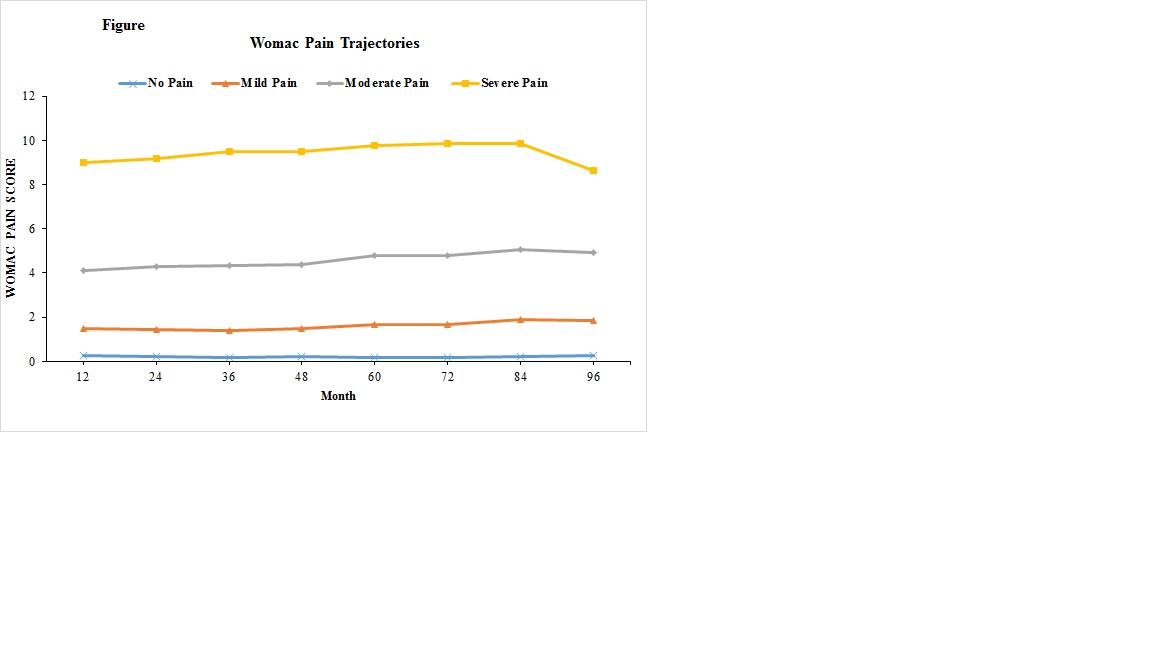Session Information
Session Type: ACR Poster Session C
Session Time: 9:00AM-11:00AM
High Dietary Fiber Intake is Associated with a Lower Likelihood of Severe Knee Pain Trajectory
Background/Purpose: Dietary fiber has been found to reduce systemic inflammation and body weight, both of which are linked with joint pain in knee osteoarthritis (OA). In this study, we assessed the association between fiber intake and knee pain trajectories over time.
Methods: In the Osteoarthritis Initiative of 4,796 participants with or at risk of knee OA, dietary fiber intake was estimated using a validated food frequency questionnaire at baseline and sex-specific quartiles of dietary fiber were created. Knee pain score was assessed using the Western Ontario and McMaster Universities Osteoarthritis Index (WOMAC) at baseline and annually for 8 years, and ranged from 0 (no pain) to 20 (worst pain). Group-based trajectory modeling was used to identify distinct WOMAC pain patterns with knee replacement (KR) cases censored at time of surgery. We used multivariable polytomous regression to assess dietary fiber and pain trajectories.
Results: Of the 4,075 participants (8,150 knees) remaining at year 8, baseline age [mean (SD)] was 61.3 (9.1) years and BMI was 28.6 (4.8) kg/m2. During the 8-year course, 4.9% of the subjects underwent KR. We identified four distinct pain trajectories with the mean posterior probabilities ≥0.87 (Figure). None of the trajectories suggested substantial worsening of pain over time. Compared with the group of no pain, participants who had higher dietary total fiber had a lower likelihood of being in the severe pain group (p-trend<0.08) with those at the highest quartile having a statistically significant 29% lower likelihood of being in this group (Table). Similar results were found for grain fiber with severe pain trajectory (p-trend<0.01). Results were similar among those with radiographic OA defined by Kellgren-Lawrence grade ≥2 at baseline or when selecting the more painful knee based on WOMAC score. Because improvement in pain was noted between baseline and month 12 for all trajectories, we examined the relation of fiber intake and WOMAC trajectories starting at month 12, and the results did not change materially.
Conclusion: Our study suggests that higher dietary total or grain fiber was inversely related to a pain trajectory characterized by severe pain over 8 years.
| Table | ||||
| Dietary total fiber | ||||
| Quartile (Q)1 [Lowest] | Q2 vs. Q1 | Q3 vs. Q1 | Q4 [Highest] vs. Q1 | |
| Median (IQR) (g/day) | 8.6 (6.4,11.3) | 12.5 (9.9, 15.5) | 15.1 (12.4, 18.9) | 20.6 (16.2, 26.3) |
| Pain trajectory groups | ||||
| No pain (n=2,848) | % 22.4 | 24.3 | 25.9 | 27.3 |
| Reference (1.00) | ||||
| Mild pain (n=3,102) | % 23.9 | 26.1 | 24.3 | 25.8 |
| Model 1* | 1.15 (0.97,1.37) | 0.90 (0.76,1.07) | 1.04 (0.87,1.23) | |
| Model 2 | 1.18 ( 0.99,1.42) | 0.93 (0.78,1.12) | 1.11 (0.92,1.33) | |
| Moderate pain (n=1,697) | % 27.9 | 25.1 | 25.5 | 23.5 |
| Model 1 | 0.91 (0.75,1.10) | 0.81 (0.67,0.97) | 0.73 (0.60,0.89) | |
| Model 2 | 0.98 (0.80,1.21) | 0.91 (0.74,1.11) | 0.86 (0.70,1.07) | |
| Severe pain (n=503) | % 36.7 | 25.8 | 21.5 | 19.2 |
| Model 1 | 0.62 (0.46,0.83) | 0.69 (0.51,0.92) | 0.54 (0.39,0.74) | |
| Model 2 | 0.72 (0.52,0.996) | 0.91 (0.66,1.24) | 0.71 (0.50,0.995) | |
| IQR: Interquartile range;* Model 1: Adjusted for age (years), sex (men vs. women), race (white vs. non-white), BMI (baseline, kg/m2), total calorie intake (kcal); Model 2: further adjusted for education level (below vs. college or above), tobacco use (never, former, current smokers), physical activity (PASE, continuous), depression scale (CES-D: <16 vs. ≥16), baseline radiographic OA status (yes vs. no), and NSAID use (yes vs. no). | ||||
To cite this abstract in AMA style:
Dai Z, Lu N, Niu J, Felson DT, Zhang Y. High Dietary Fiber Intake Is Associated with Lower Likelihood of Severe Knee Pain Trajectory [abstract]. Arthritis Rheumatol. 2016; 68 (suppl 10). https://acrabstracts.org/abstract/high-dietary-fiber-intake-is-associated-with-lower-likelihood-of-severe-knee-pain-trajectory/. Accessed .« Back to 2016 ACR/ARHP Annual Meeting
ACR Meeting Abstracts - https://acrabstracts.org/abstract/high-dietary-fiber-intake-is-associated-with-lower-likelihood-of-severe-knee-pain-trajectory/

